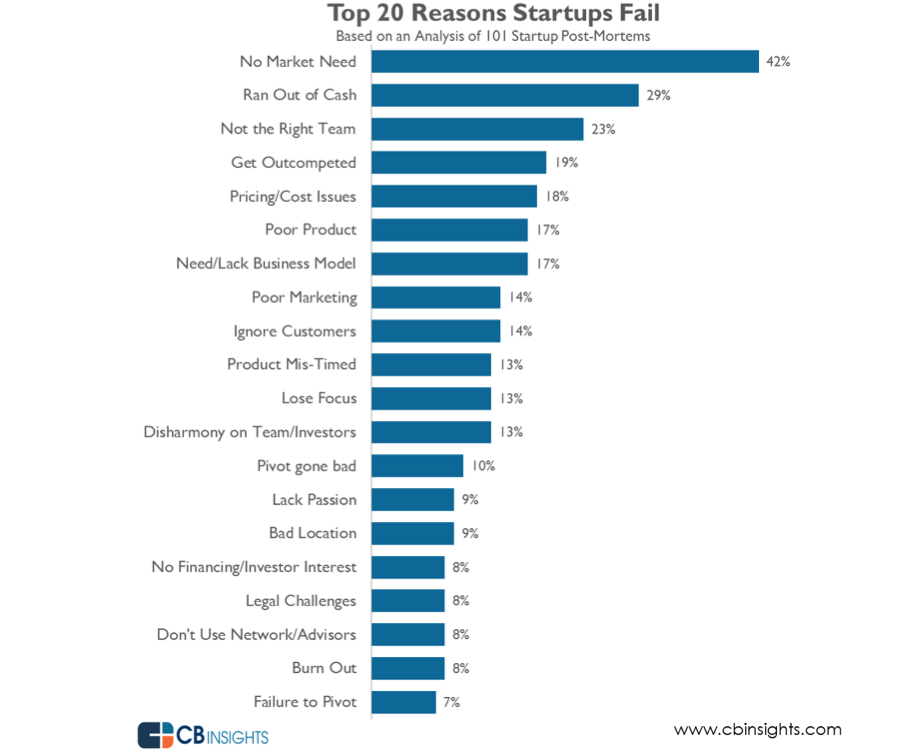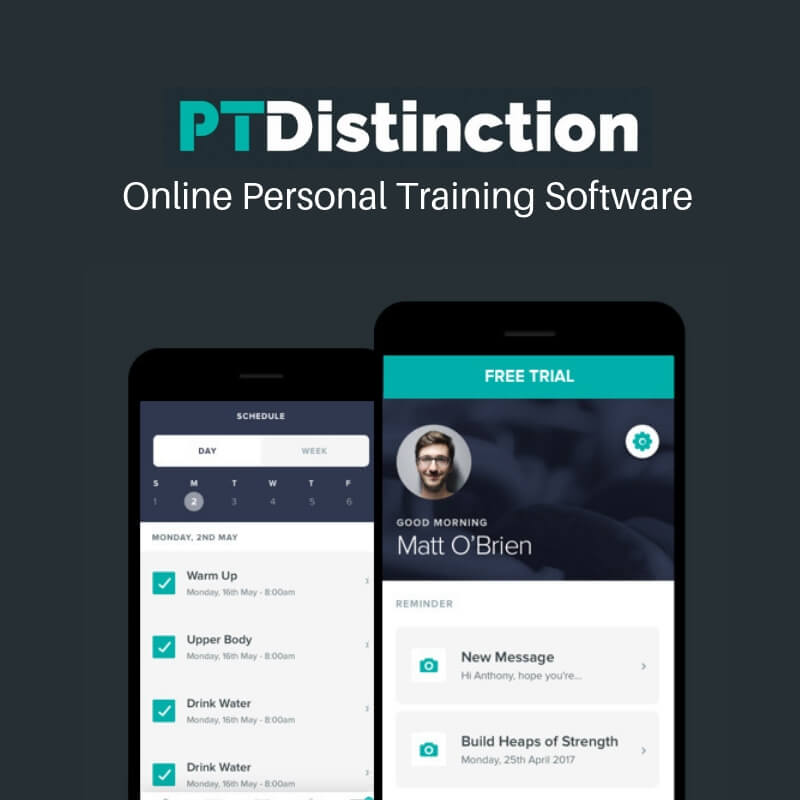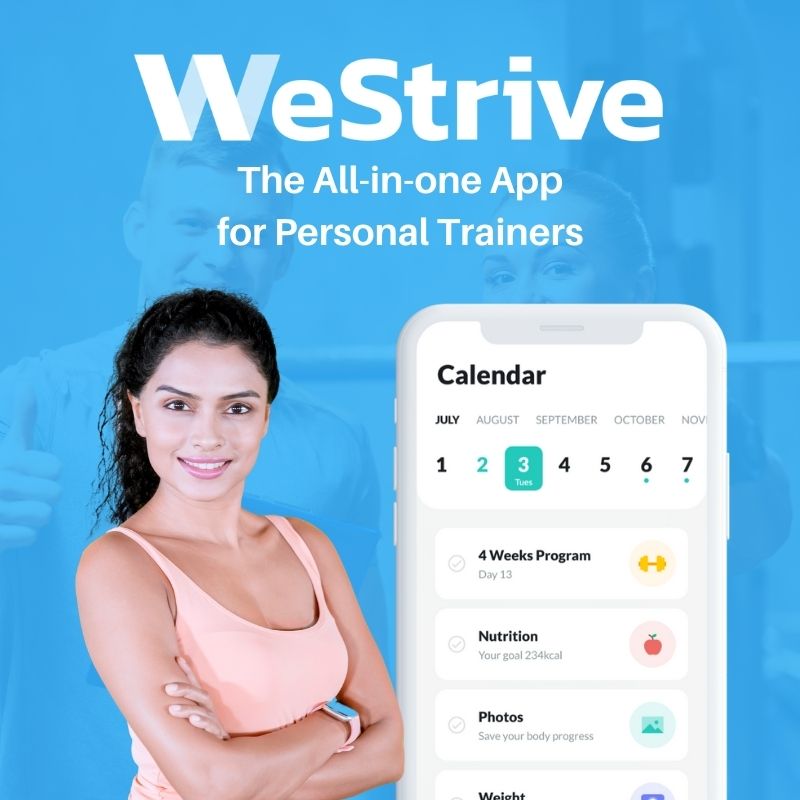Earlier this year CBS insights published a blog post called 204 Startup Failure Post-Mortem. A compilation of the most common start up failures that caused businesses to fold.
They then compiled the data and created a list of a the top 20 reasons start ups fail. You can see that list below.
(Many startups offered multiple reasons for their failure, hence why the percentages for each reason total more than 100 percent.)
(Many startups offered multiple reasons for their failure, hence why the percentages for each reason total more than 100 percent.)
In this article, we’re going to address each of the top 20 reasons businesses fail to help you predict possible problems in your own fitness business so that you can start thinking of ways to overcome them.
1. Failure to Pivot (7%)
Failure to Pivot is the inability to adapt to changing times. This might include changing your business strategy, your niche or your products and services to accommodate trends.
Lesson: Don’t set your products, services and niche in stone. You might start off with one type of clientele and soon find that another type of client is attracted to your services.
You might also find that your current clients aren’t responding well to your existing services.
Either way, it’s not good business sense to be stubborn. Make small changes, give them enough time to track any measurable results and react accordingly.
You might also find that your current clients aren’t responding well to your existing services.
Either way, it’s not good business sense to be stubborn. Make small changes, give them enough time to track any measurable results and react accordingly.
2. Burn Out (8%)
This can be a big problem if you’re running a personal trainer business on your own. You’re not only the service provider, you’re also the manager and marketer of your business.
I remember working from 6am until the afternoon with clients, trying to write a blog for my site and train myself before more clients at 4 or 5pm in the evening.
Time spent working then significantly increased while also trying to build My Personal Trainer Website at the same time.
I remember working from 6am until the afternoon with clients, trying to write a blog for my site and train myself before more clients at 4 or 5pm in the evening.
Time spent working then significantly increased while also trying to build My Personal Trainer Website at the same time.
Lesson: Burn out is a real problem. Managed your schedule ahead of time, get your self set up nutritionally and make sure sleep is on your list of priorities. I found six and half hours sleep a night very manageable but everyone copes differently when it comes to sleep so find what works for you.
3. Don’t Use Network/Advisors (8%)
There are literally hundreds of personal trainers who are either at the same stage of business as you, a few steps behind or way ahead within arms reach.
Most fitness business owners will chat to you about their business and you can chat to them about yours.
Most fitness business owners will chat to you about their business and you can chat to them about yours.
Lesson: Make sure to connect with other trainers and business owners to lear about mistakes, strategies and tips to improve your business. You can do this face to face or online. A few of my favourite Facebook Groups include:
- My Personal Trainer Website - The company group. We mostly talk about digital marketing.
- UK PT’s - Full of, you guessed it, PT’s from the UK. Lots of great actionable advice.
- Online Trainers Unite - A Group dedicated to helping trainers with their online training.
4. Legal Challenges (8%)
For the most part, there aren’t many legal challenges in your first year of doing business. You may come across a few branding issues depending on your business name but they’re usually easily sorted.
One thing that might crop up if you intend to run your own studio is getting the paperwork in order with your local council or state.
One thing that might crop up if you intend to run your own studio is getting the paperwork in order with your local council or state.
Lesson: You can check whether your particular business name or brand is taken online using a Business Name Availability checker.
For legal issues with studio space, check with your local government to learn how to get all the right stamps and signatures before jumping in head first
For legal issues with studio space, check with your local government to learn how to get all the right stamps and signatures before jumping in head first
5. No Financing (8%)
Almost all personal trainers I speak to have zero financing. unfortunately, the barrier to entry to become a PT is a $1,000 Level 3 PT course which doesn’t usually come with any business skills whatsoever.
There are lots of ways to get money for your business including government grants, business and personal loans.
There are lots of ways to get money for your business including government grants, business and personal loans.
Lesson: Money is oxygen to a business. While starting out with nothing is possible, it’s very difficult and you’ll find momentum is very slow.
Don’t be afraid to borrow money. With a good business plan you can get a business loan from your bank. Even a few thousand dollars will help you get your basic marketing assets set up so you can position your business in front of people who might buy from you.
Don’t be afraid to borrow money. With a good business plan you can get a business loan from your bank. Even a few thousand dollars will help you get your basic marketing assets set up so you can position your business in front of people who might buy from you.
6. Bad Location (9%)
If you’re working in a chain gym, location shouldn’t be much of an issue because much of the marketing to bring in new local leads is already done by the gym owner.
For the personal trainers who have their own studios, you’re probably already aware that location is paramount, especially if you plan to capitalise on walk-ins.
For the personal trainers who have their own studios, you’re probably already aware that location is paramount, especially if you plan to capitalise on walk-ins.
Lesson: To make the most of local traffic you’re either going to need a kick ass location, kick ass marketing or both.
Be sure to scope out the best location for your business based on where people commute to and from work. If you can’t get the best location, don’t fret. People are usually willing to travel provided it’s reasonably convenient.
Be sure to scope out the best location for your business based on where people commute to and from work. If you can’t get the best location, don’t fret. People are usually willing to travel provided it’s reasonably convenient.
7. Lack Passion (9%)
Surprisingly this is an actual issue in the fitness industry. Personal trainers often have enough passion to be a personal trainer, but not enough to be a business owner.
From day one, recognise that you are a business owner, not a personal trainer. Personal training is your service, not your business.
From day one, recognise that you are a business owner, not a personal trainer. Personal training is your service, not your business.
Lesson: Be prepared to spend a lot of hours learning how to run a business and don’t get caught in the trap of thinking that another fitness or nutrition course will save your business.
To provide exercise prescription you need knowledge of anatomy and physiology so it only makes sense that to run a business you need at least some very basic business skills.
To provide exercise prescription you need knowledge of anatomy and physiology so it only makes sense that to run a business you need at least some very basic business skills.
8. Pivot Gone Bad (10%)
Remember, your pivot is a change in business strategy. Keeping an eye on the curve can sometimes mean a change in clientele or a change in service. But not all changes are good changes.
Sometimes a change in your business ends up being a bad prediction and can be a huge set back.
Sometimes a change in your business ends up being a bad prediction and can be a huge set back.
Lesson: When making business changes, make them one at a time and as small as possible. It’s better to adapt in stages than it is to force a complete business restructure.
9. Disharmony in Team/Investors (13%)
If you’re a solo trainer, the only disputes you’ll have will be the disputes you get between your inner personal trainer and inner business owner. That’s normal and usually sorts itself out.
But managing a team comes with it’s whole host of complications including hiring new staff and employee disputes.
In the book Rich Dad, Poor Dad by Robert Kiyosaki, Robert suggests that the most difficult transition between sole trader and business owner is taking on new people.
You’ve been doing a job so well by yourself that anyone you invite in to the business can’t possibly do as good a job as you.
But managing a team comes with it’s whole host of complications including hiring new staff and employee disputes.
In the book Rich Dad, Poor Dad by Robert Kiyosaki, Robert suggests that the most difficult transition between sole trader and business owner is taking on new people.
You’ve been doing a job so well by yourself that anyone you invite in to the business can’t possibly do as good a job as you.
Lesson: To combat this, instead of taking on qualified and experienced team members, consider training them yourself, your way!
This will reduce stress for you and also reduce team disputes because everyone is working on the same page.
This will reduce stress for you and also reduce team disputes because everyone is working on the same page.
10. Lose Focus (13%)
Losing focus is a pretty common problem when you’re running a business on your own. Between juggling management and marketing roles, you’re also writing programs and scheduling for clients.
Lesson: Setting goals is the number one way to stay on track. You recommend it to your clients so it only makes sense to implement the same strategy within your own business.
Create clear short, medium and long term goals for you business and take daily steps to achieve them.
It’s also important to recognise that feeling deflated, tired and out of focus is all part of the game. But don’t stress, let it pass (it will) and move on as soon as you can.
Create clear short, medium and long term goals for you business and take daily steps to achieve them.
It’s also important to recognise that feeling deflated, tired and out of focus is all part of the game. But don’t stress, let it pass (it will) and move on as soon as you can.
11. Product Mistimed (13%)
Luckily for us personal trainers, we mostly sell evergreen services that can be utilised all year round, not one off products.
But selling services can also come with time related risks, especially when selling things like challenges and transformation packages.
But selling services can also come with time related risks, especially when selling things like challenges and transformation packages.
Lesson: To make sure you don’t mistime your product launch be sure to schedule your launch around times that people are most likely to need or buy them.
For example, expensive packages might not sell closer to Christmas and your Summer Body Blast marketing should be well under way before summer arrives.
For example, expensive packages might not sell closer to Christmas and your Summer Body Blast marketing should be well under way before summer arrives.
12. Ignore Customers (14%)
This one’s a no brainer. Personal training is one of the most customer centric jobs you could do so listening to your clients is paramount.
Your clients are not only the lifeblood of your fitness business but they’re also your biggest marketing asset.
Your clients are not only the lifeblood of your fitness business but they’re also your biggest marketing asset.
Lesson: Regularly question your clients about what they like, what they don’t like, what they need help with and what they want to learn about.
You can use this information to make necessary changes to your business and also as ammunition for your blog posts and social media posts.
You can use this information to make necessary changes to your business and also as ammunition for your blog posts and social media posts.
13. Poor Marketing (14%)
Possibly one of the biggest issues I personally see within the personal training industry. Probably because I’m “in” it all day every day. Marketing.
Unfortunately, a PT qualification doesn’t come with the business or marketing skills that are essential to making a business grow.
Unfortunately, a PT qualification doesn’t come with the business or marketing skills that are essential to making a business grow.
Lesson: You took a PT course to become a trainer, so take a marketing course to become a better marketer. It’s really that simple.
And no, it’s not expensive at all. You can take our free marketing courses in the Academy to get a full understanding of how your clients think and how they might better respond to your marketing strategies.
And no, it’s not expensive at all. You can take our free marketing courses in the Academy to get a full understanding of how your clients think and how they might better respond to your marketing strategies.
14. Need/Lack Business Model (14%)
A personal training business model is relatively straight forward but it’s often overlooked as unnecessary admin.
However, once you have an actual business model in place, it becomes easier to create goals and therefore gives you something to measure.
However, once you have an actual business model in place, it becomes easier to create goals and therefore gives you something to measure.
Lesson: Fill out a comprehensive business plan at least once. Even if you don’t know all of the answers just yet you can come back to it later.
Don’t make the mistake of thinking that a business plan is set in stone. it’s more like a client program that changes over time because of injury or holidays.
Don’t make the mistake of thinking that a business plan is set in stone. it’s more like a client program that changes over time because of injury or holidays.
15. Poor Product (17%)
Your actual product is pretty much set in stone unless you specialise in something specific. Personal training is personal training. But how you position your services can either attract or repel interested clients.
For example, personal trainers often try to differentiate themselves by calling themselves “lifestyle coaches” or “healthpreneurs”.
That’s all well and good but most of your clients are looking for a personal trainer and if they see anything other than “personal trainer” in your marketing then you might lose them.
For example, personal trainers often try to differentiate themselves by calling themselves “lifestyle coaches” or “healthpreneurs”.
That’s all well and good but most of your clients are looking for a personal trainer and if they see anything other than “personal trainer” in your marketing then you might lose them.
Lesson: Meet your clients where THEY are at in their buyer journey. Give them what they think they need and then offer them what they actually need after you’ve established some rapport.
16. Pricing/Cost Issue (18%)
Pricing is such a tricky subject that we created resources to help you pricing your services, check out the Online Personal Training Package Price Calculator.
There’s loads of advice out there on pricing, whether you should give away free sessions and whether you should go for packages or monthly fees.
Ultimately it comes down to your business model and your long term plans (this is where that business plan comes in again).
There’s loads of advice out there on pricing, whether you should give away free sessions and whether you should go for packages or monthly fees.
Ultimately it comes down to your business model and your long term plans (this is where that business plan comes in again).
Lesson: Start as you mean to go on. Granted, a more qualified or experienced trainer can charge more based on the results they can get their clients. They’re a sure thing and you might not be if you’re just starting out.
But that doesn’t mean you should low ball your prices just to get clients. Instead, consider offering discounted rates in exchange for comprehensive testimonials. That will get you the social proof you need to justify the prices you want to charge.
And remember, when it comes to prices, the market (your clients and competition) ultimately decide. You just need to figure out where you fit within that market.
But that doesn’t mean you should low ball your prices just to get clients. Instead, consider offering discounted rates in exchange for comprehensive testimonials. That will get you the social proof you need to justify the prices you want to charge.
And remember, when it comes to prices, the market (your clients and competition) ultimately decide. You just need to figure out where you fit within that market.
17. Get Outcompeted (19%)
Again, we’re going back to that business plan. in particular the part where you scope out your competition.
If your town is already full of bootcamp instructors that have great reputations, you might get outcompeted if you didn’t spot that because you didn’t fill out a personal trainer business plan.
If your town is already full of bootcamp instructors that have great reputations, you might get outcompeted if you didn’t spot that because you didn’t fill out a personal trainer business plan.
Lesson: The minimum competitor research you should be doing is a Google search. If you’re a local trainer, do a search on Google for personal trainers in your area, the same way your clients would.
If you’re online, search trainers who work within the same niche as you.
You’ll not only get a good idea of how hard you’re going to need to work but you’ll also be able to see what businesses are succeeding and why.
If you’re online, search trainers who work within the same niche as you.
You’ll not only get a good idea of how hard you’re going to need to work but you’ll also be able to see what businesses are succeeding and why.
18. Not the Right Team (23%)
I was surprised to find that so many companies fail because of the team members they employ. But it makes complete sense when you think about it.
If you have a crappy marketer, a crappy trainer or employees with a bad attitude, it’s only understandable that your company isn’t going to progress as you thought it would.
If you have a crappy marketer, a crappy trainer or employees with a bad attitude, it’s only understandable that your company isn’t going to progress as you thought it would.
Lesson: Your team doesn’t just consist of you and the people you employ. It also consists of people who you hire to do certain tasks for your business. Like your social media manager, your website designer, your marketer or your accountant.
Finding the right team members is never easy and it takes time. Don’t just jump in to bed with the first service provider you find. Make sure they have a proven track record and that you get on with them on a personal level if you need to work closely together.
Finding the right team members is never easy and it takes time. Don’t just jump in to bed with the first service provider you find. Make sure they have a proven track record and that you get on with them on a personal level if you need to work closely together.
19. Ran Out of Cash (29%)
I’m not at all surprised this one is in the top two. Most trainers I meet start up on an extremely low budget, with zero funding and often struggle for the first 1-3 years of business just to make ends meet.
Money is oxygen to a business and it’s both essential to keep your business running and to put food on your table.
Money is oxygen to a business and it’s both essential to keep your business running and to put food on your table.
Lesson: Making sure you don’t make any of the previous mistakes can save you loads of money but nothing will serve your businesses income column better than an effective marketing strategy.
Again, create a business plan, set goals, try not to mess up, get your clients results and make sure everybody knows about it.
Again, create a business plan, set goals, try not to mess up, get your clients results and make sure everybody knows about it.
20. No Market Need (42%)
Luckily for us, they’ll always be a market for personal trainers. however, how personal training is delivered will change.
Right now, even though most personal training still takes place face to face, we’re shifting over to online training. While most people don’t completely understand it, they will.
I don’t think this necessarily means face to face training will die, there might just be less of a market need for it.
Right now, even though most personal training still takes place face to face, we’re shifting over to online training. While most people don’t completely understand it, they will.
I don’t think this necessarily means face to face training will die, there might just be less of a market need for it.
Lesson: It’s important to be aware of whether there is a local need for your services. If the market is saturated you might need to reconsider your options.
Times change and you need to keep an eye on these changes to make sure your business doesn’t get left behind.
Times change and you need to keep an eye on these changes to make sure your business doesn’t get left behind.









